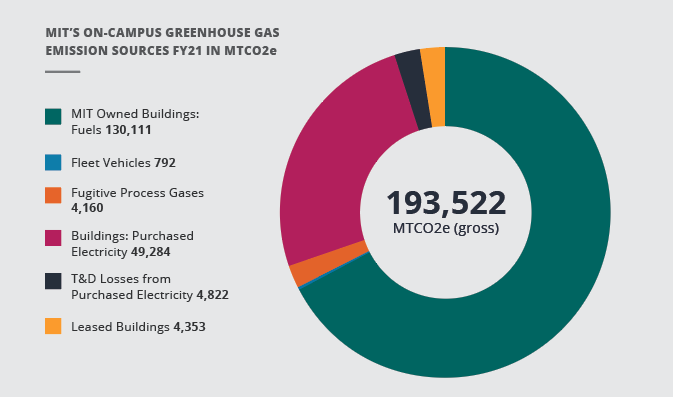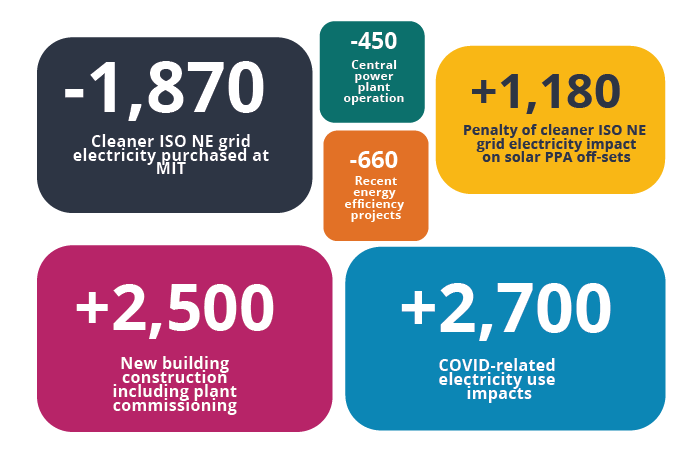Moving Towards a Net-Zero Campus By 2026
In 2021, MIT’s greenhouse gas (GHG) emissions remained relatively flat, with emissions rising approximately 2% from 2020 levels. This slight increase was driven in part by the addition of new buildings and pandemic-related building safety measures that ultimately required higher energy consumption. However, these higher emissions were offset through building-level energy efficiency investments, operational efficiency of the Central Utilities Plant (CUP), and improvements in the New England regional electricity grid. Since 2014, MIT has reduced its net emissions by approximately 22%. Of that net reduction achieved to date, approximately 13% is attributed to our solar power purchase agreement, 8% to on-campus mitigation measures, and less than 1% to carbon improvements to the local electricity grid. This sets MIT on the path toward the newly announced 2026 goal of net-zero emissions.


Sources of Reduced Emissions
In FY21, MIT realized a net increase of approximately 3,400 metric tons of GHG emissions from the previous year. This net change was driven by several primary factors as highlighted below.

While the Institute continues to assess the ongoing impact of the pandemic on our campus energy use and greenhouse emissions, a few data trends have emerged. Since the campus significantly reduced its occupant density in early 2020:
-
At the building-level, electricity use on campus declined slightly with fewer people using electricity in offices, labs, and residences. However, natural gas use increased slightly to meet the higher building ventilation rates activated to reduce COVID-19 risk.
-
In addition, campus added new buildings including the commissioning of the expanded central utility plant, which contributed a net increase of emissions. However, growth was offset with the completion of several building energy efficiency projects and increased optimization of plant operations.
MIT Commits to Net-Zero Emissions by 2026 and Elimination of Direct Emissions by 2050
In 2021, the Institute launched Fast Forward: MIT’s Climate Plan for the Decade, which accelerates MIT’s commitment to innovate climate change solutions. The plan calls for MIT to achieve net-zero campus emissions by 2026 and to eliminate direct emissions by 2050. To advance these goals, the plan establishes several targeted strategies including investing in large-scale, off-site renewable energy and carbon reduction projects; transitioning to an electrified campus vehicle (EV) fleet and doubling EV charging infrastructure; scaling up on-campus solar photovoltaic capacity; incorporating and offsetting key Scope 3 emission sources; advancing climate resiliency planning; and expanding the boundaries of MIT’s greenhouse gas inventory to include most MIT-owned facilities outside of Cambridge.
Central Plant Renewal & Expansion Nears Completion
In 2021, the expanded and renewed Central Utilities Plant became operational, including system testing and commissioning, ushering in a new phase of efficient, on-campus distributed power generation. Once fully commissioned, the state-of-the-art, tri-generation plant is expected to reduce MIT’s annual emissions by approximately 10% annually. Additional investments in converting steam distribution systems to hot water systems continued in 2021. The testing and commissioning of the new plant equipment required the short-term additional use of natural gas, which increased our emissions by approximately 1,000 MTCO2e.
Summit Farms Solar Facility
MIT continued to benefit from the Institute’s 25-year commitment to purchase electricity generated through its Summit Farm Power Purchase Agreement (PPA). The agreement was established in 2016 and enabled the construction of a roughly 650-acre, 60-megawatt solar farm on fallow farmland in North Carolina. Through the purchase of 87,073 megawatt hours of solar power in 2021, MIT offset over 27,000 MTCO2e from on-campus operations in 2021.


